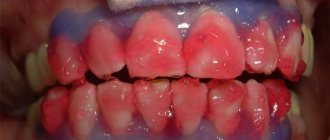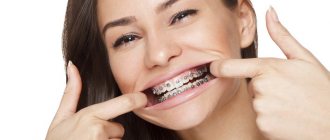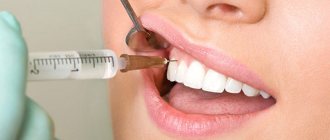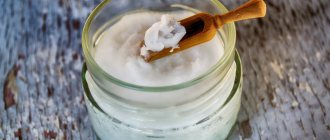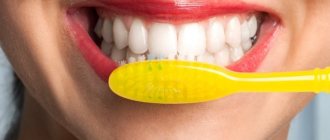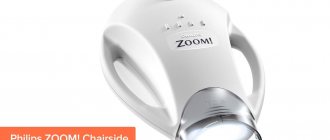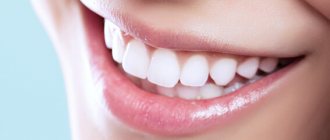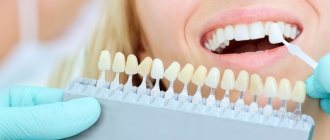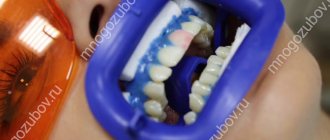Chemical whitening of non-vital teeth (i.e., pulpless), so-called intracoronal (inside the tooth) whitening of one tooth in the dentist’s office. This type of whitening is used to eliminate internal discoloration of one (or several) teeth that has arisen due to a non-systemic reason. The only type of whitening that is a medical procedure and for which there are indications.
Indications for use:
- Previously pulpless and discolored teeth;
- Teeth that have changed color as a result of injury;
- “Resorcinolized teeth” (resorcinol-formalin paste was used to fill the canals, giving the tooth a pink tint).
Contraindications:
- Age up to 18 years;
- Pregnancy;
- Lactation;
- Allergic reactions to hydrogen peroxide;
- Mental illnesses;
- Hard tissue defects in the cervical area;
- Enamel cracks;
- The presence of anchor and other metal pins in the root canal;
- Severe destruction of the tooth crown;
- Changes in tissue around the root apex, visible on x-ray.
Advantages:
- Possibility of tooth preservation;
- Preservation of tooth shape;
- Possibility to avoid expensive prosthetics.
Whitening of discolored teeth is carried out from the pulp chamber. The technique is based on filling the pulp chamber of the tooth with a chemical reagent. These can be gels, paste-like mixtures, based on drugs such as:
- Sodium perborate (“Endoperox” from Septodont is a powder that is stable in a dry environment, but when interacting with warm air, water, or acid, it decomposes into sodium metaborate, hydrogen peroxide and oxygen. When mixed with hydrogen peroxide, its effect is enhanced).
- Carbamide peroxide (“Belagel O” from Vladmiva - a gel with 20% and 30% concentration of the active substance, it also contains potassium ions, which reduce sensitivity).
- Hydrogen peroxide (“Opalescence Endo” from Ultradent – a gel containing 35% hydrogen peroxide).
catalogue of articles
In the previous article we told you about companies Bio—D and about those harmful components, which are
NOT used in the production Bio - D home care products .
Now we will talk about those components that
you will encounter in our products .
To the average person they may seem scary. We'll try to clarify the situation a little. Sodium sulfate
Sodium sulfate (Na2SO4), also called sodium sulfate, is widely used as an industrial chemical. It is an inorganic compound, the main ingredients being sodium (Na) and sulfur (S), anhydrous sodium sulfate occurs in nature as the mineral Thenardite. It can be created as a by-product of certain industrial chemical processes. It is often used in powdered and liquid detergents and soaps. Sodium sulfate is not considered dangerous under normal circumstances. It is not flammable, which is a major risk factor since there are always sources of heat and friction in the production, storage and transportation of chemicals. This chemical is not considered toxic because it does not react dangerously with air or water to cause exothermic or endothermic reactions.
Sodium carbonate
Na2CO3 (sodium carbonate) - soda ash. Sodium carbonate is used in the production of washing and cleaning powders and liquids, enamels, soap and glass. Sodium carbonate is also used to soften water. Functions of sodium carbonate: acidity regulator, oxidizing agent.
Sodium perborate (
sodium perborate)
Peroxide salt - sodium peroxoborate (perborate). Solid sodium perborate contains about 10.4% active oxygen; when dissolved in water, a solution of hydrogen peroxide is formed. An aqueous solution of sodium perborate can be used to bleach both artificial and natural fabrics. The mild bleaching effect of perborate gives fabrics a freshness that cannot be achieved with regular washing with soap or surfactants alone.
Zeolites (
zeolit)
In environmentally friendly washing powders, more expensive and safe zeolites are used instead of phosphates.
Zeolites
used in washing powders to eliminate water hardness. Another important property of zeolites is the ability to ion exchange - in an aqueous environment they react with calcium and magnesium ions, bind them during washing, preventing them from settling on clothes and on the internal parts of the washing machine.
Sodium citrate
Sodium
citrate is the sodium salt of citric acid. In the food industry it is used as a spice and as a preservative. Changes the acidity of the environment. Protects the internal parts of the washing machine from corrosion. Prevents the formation of excess foam. Replaces phosphates, allowing surfactants to better penetrate the fabric and cleanse dirt, thereby reducing the amount of surfactants in the detergent.
Sodium Gluconate.
Used in detergents to prevent limescale deposits and to increase the effectiveness of detergents. On an industrial scale, sodium gluconate is produced through chemical reactions. Sodium gluconate is completely biodegradable and does not harm humans and the environment.
Sodium chloride.
Sodium chloride
- chemical compound NaCl, sodium salt of hydrochloric acid, sodium chloride.
Sodium chloride is known in everyday life as trusted salt, of which it is the main component. Sodium chloride is found in significant quantities in sea water, creating its salty taste. It occurs naturally in the form of the mineral halite (rock salt).
How is intracoronal bleaching performed:
- Consultation, history taking, examination, treatment plan.
- Assessment of the condition of periapical tissues and the quality of root canal obturation using x-rays, and, if necessary, retreatment of the root canal.
- Determining the color of the tooth, recording it in the chart, taking starting photographs.
- Tooth isolation using a cofferdam.
- Removal of filling material from the oral surface of the tooth, unfilling of the root canal 3 mm below the mouth of the canal.
- Creating an “orifice barrier” using a filling material between the root canal and the area where the bleach will be placed.
- Adding bleach to the tooth cavity, isolating it with a cotton swab, filling the cavity with cement.
- A repeat visit is scheduled after 3-5 days, depending on the bleach used and the degree of tooth discoloration.
- Recommendations are given to the patient at home to monitor the change in tooth color; it is possible that a second visit will be needed earlier.
- After 3-5 days, remove the filling and replace the bleach if the desired effect is not achieved, or install a temporary filling to check the color preservation.
- When the desired effect is achieved, the final restoration is carried out.
The occurrence of the disease Dental plaque
The main reasons for tooth discoloration are:
- Due to frequent consumption of drinks such as very strong tea, coffee, as well as smoking tobacco, teeth acquire a color from yellow-brown to almost black. In such cases, the color of the surface layers of enamel changes;
- violation of the structure of the teeth - so-called tetracycline teeth, dental fluorosis;
- penetration of pigments into dentin during its development: for example, bilirubin causes staining of dentin in children with severe liver damage;
- attraction errors;
- injuries;
- age-related color changes.
General issues
(It is imperative to clarify whether the patient agrees to a darker color if the dentist convinced him not to achieve a too white shade of his teeth.Technique for in-office whitening of vital teeth with the modern Hi Lite system. The Hi Lite system liquid contains 35% hydrogen peroxide, which is the active principle. Work safety requires the use of gloves, a mask and protective glasses for the doctor, the assistant and a rubber dam for the patient.
The use of a bleaching agent near exposed dentin or cement, as well as in case of individual hypersensitivity of the patient, is contraindicated.
The whitening effect can be achieved in one visit. Low effectiveness of treatment requires repeated exposure after 7 days. There is no acid attack.
Lubricate the gums with Vaseline or protective cream. Isolate the teeth to be whitened with a rubber dam; in addition, you can use a wax-coated thread.
Clean your teeth with a paste that does not contain glycerin or fluoride. Mix three drops of liquid and one spoon of powder to a homogeneous mass of medium viscosity.
To avoid reducing the activity of the gel, immediately apply the mixture to the area of the teeth to be whitened, 1 mm thick (Fig. 191).
The impact is carried out mainly on the vestibular surface. If necessary, the gel is also applied to the lingual surface. The procedure can be repeated from 3 to 6 times (no more).
If necessary, the whitening session can be repeated after 7 days. To activate the composition, you can use a lamp that hardens the composite for 3-5 minutes (light activation). Chemical activation occurs independently in 7-9 minutes.
The completion of the procedure can be judged by the discoloration of the gel, which is immediately removed with a gauze swab. After completing the whitening sessions, the tooth surface is thoroughly washed off with water for 1 minute and the rubber dam is removed.
The patient is warned to refrain from smoking, eating food and drinks containing pigments for 24-48 hours. Controlled whitening (under the supervision of a doctor) involves the introduction into the oral cavity of a protective tray (spoon, plate) filled with a bleaching agent, including high concentration carbamide peroxide (35-40%), for a period of 30 minutes to 2 hours.
The patient remains in the dentist's chair or waiting room while the aligner is removed. Another visit can be scheduled after 6 days, during which the patient continues whitening on his own at home.
In this case, the dental technician makes an individual protective plate, which is given to the patient with detailed instructions on how to use the drug independently: a whitening gel containing 15% carbamide peroxide is applied for 1 hour, 2 times a day for 5 days.
The patient writes down in a diary every day everything related to the procedure, including changes in color, tooth sensitivity, and gum irritation. If any of the symptoms persist for more than 48 hours, treatment is stopped.
In the absence of side effects, the effects are completed after 5 days, and the tissue condition is assessed according to the scheme adopted at the beginning of the study: subjective assessment of the color of the teeth by the patient, comparison with the VITA scale and photographing of the teeth, as well as recording the condition of the gums. Using only the clinical whitening method leads to a change in shade by an average of 4.8 points.
The combined use of clinical and home exposure can increase the whitening effect to an average of 7 units.
It should be remembered that drying teeth during in-office whitening with a concentrated composition of hydrogen peroxide can cause tooth hypersensitivity, as well as lead to erroneous reading of the results of tissue lightening. Namely, enamel containing a reduced amount of water acquires pronounced whiteness.
Subsequent natural rehydration of the dried bleached tooth gives a slight dark tint and forms an erroneous interpretation of the phenomenon as a return of pigmentation (usually after 1-2 weeks). The fluidity of a 35% hydroperite solution contributes to irritation of soft tissues. Such cases can be avoided by using a rubber dam.
In addition, the use of a high viscosity gel or a thick mixture (powder-liquid) significantly reduces the permeability of the bleaching composition under the rubber dam. When using special barriers made from foaming agents, the gingival margin is protected more effectively than with a rubber dam (Fig. 192).
| Rice. 192. Using a gingival barrier when whitening the 12th tooth |
However, these gingival protective barriers do not cover the lips and tongue, so when whitening a large number of teeth or an entire arch, the use of a dental dam is highly recommended.
Abundant irrigation and local applications of antiseptic ointment can reduce irritation from direct contact with the bleaching agent.
Whitening a single tooth. Individual teeth can be effectively whitened in a clinic under medical supervision using 35% hydrogen peroxide, but at-home whitening may be recommended (and even preferred).
The combination of these two methods (a single clinical exposure for 15 minutes and home lightening for five days) allows achieving high whitening efficiency.
The clinic uses 35% hydrogen peroxide (urea) gel, which is preheated by immersing the syringe in hot water for 5 minutes before applying it to the teeth.
High concentration of peroxide, activation by light provides an immediate (after 5 minutes) aesthetic result. The so-called “jump at the start” method is indicated for high and medium intensity teeth staining, including tetracycline stains. Further exposure for 4-6 weeks using the “safe home method” provides a high and lasting effect.
For home whitening, a protective plate is made for the entire dental arch; however, the whitening agent is applied only to the area of the individual tooth being bleached. To make it easier for the patient to select the required area to apply the gel, a notch is made above the place on the tray where the crown of the dark tooth is projected.
After lightening an individual tooth, if necessary, the entire dental arch can be bleached (Fig. 193).
| Fig. 193 Whitening of one (12) tooth and lightening of the entire dental arch is required |
Whitening of devitalized teeth.
Exposure can be carried out through various methods of both clinical and home use. The products used are applied both inside and outside the tooth.
The most widely recommended treatment options are:
- clinical bleaching (inside or outside) using 30% or 35% hydrogen peroxide with acceleration of the decomposition reaction by heat or light;
— “on-the-go whitening” by placing a composition of hydrogen peroxide and sodium perborate or a mixture of sodium perborate and water into the tooth cavity under an airtight bandage for 2-4 days;
- home whitening with 10% carbamide peroxide with an open tooth cavity (from the inside and outside at the same time);
— “night” tooth whitening only from the outside (10% carbamide peroxide); - combined use of office and then independent exposure.
The general treatment regimen for a pulpless tooth can be as follows: removing the filling, isolating the root filler with phosphate cement, whitening the tooth from the inside with 30% H2O2 with heat activation.
If the effect is insufficient, bleaching is carried out with a mixture of hydrogen peroxide and sodium perborate under a sealed bandage (“on the go”).
Endoperox (Septodont) tablets are used in a similar way. For internal effects, you can use endoperox - tablets containing carbamide peroxide.
The main properties are determined by the oxidizing effect of the released oxygen, which is a bleaching, bactericidal and mechanical cleaning agent.
Endoperox is indicated for whitening pulpless teeth stained, for example, with hemoglobin. Before bleaching, you need to make sure that the canals are perfectly sealed with solid paste.
Directions for use: rinse the tooth cavity; crush the tablet and prepare a paste by mixing the resulting powder with a small amount of glycerin; thoroughly cover the bottom and walls of the cavity with the resulting paste; cover with a cotton swab and seal with cement; After 4-5 days, examine the patient. If satisfactory discoloration is achieved, fill the tooth.
If not, then you can repeat the procedure, which is absolutely harmless to dentin. In order not to exceed the required degree of whitening and at the same time obtain sufficient effect, it is advisable to carry out this procedure in several visits.
For some types of tooth staining caused by metallic sulfur compounds, a paste can be prepared using endoperox and a chelate solution. The composition prepared in this way cannot be used on enamel.
Treatment can be repeated 2-3 times. Further whitening may include “overnight safe” exposure to 10% carbamide peroxide under a special protective plate daily until results are achieved. The whitening technique devitalizes the tooth with the double activation composition Hi Lite.
The gums are protected with Vaseline or a special cream (Orabase). Alveolar bone resorption and ligament failure are prevented by using polycarboxylate or zinc phosphate cement as a protective barrier, placed at the canal orifice and the area of the missing pulp chamber wall.
Glass ionomer cement should not be used for this purpose, since it can adsorb the bleaching agent. Then you need to prepare a homogeneous medium-viscosity mass of whitening gel by placing 3 drops of liquid and 1 full spoon of powder on a special plate.
The finished gel is immediately introduced into the tooth cavity and applied to the vestibular and lingual surfaces. Activation of the gel can be done using a lamp to cure the composite material (3-5 minutes) or occur independently (7-9 minutes).
The oxidation reaction ends with the discoloration of the blue-green gel. The inactivated gel is removed from the tooth surface with a gauze pad and from the pulp chamber using an excavator.
If necessary, the whitening procedure can be repeated up to 6 times. Only after completing the whitening procedure, the tooth surfaces are thoroughly washed off with water for 1 minute and the rubber dam is removed.
The patient is not recommended to consume foods that can pigment the enamel for 24-48 hours.
If it is necessary to make restorative structures (fillings, veneers), you should wait 2 to 6 weeks after completion of bleaching, in order to avoid the risk of reducing the adhesion of the material to the hard tissues of the tooth. The combination of bleaching with enamel thinning and microabrasion is used for moderate hypocalcification, brown spots as a result of dismineralization of intact teeth, and mild fluorosis.
The technique includes microreduction - reduction of enamel thickness by grinding, as well as microabrasion through exposure to an acid-containing abrasive paste, followed by teeth whitening.
In cases where the spots are located superficially (up to 300 microns), it can act 1 as an alternative to invasive procedures.
The positive aspects of this method are the low cost for the patient, minimal time spent on treatment, insignificant loss of enamel and, if necessary, the possibility of repeated exposure.
It is preferable to start this technique from the distal parts of the dentition in order to determine the depth of the lesion and the compliance of the pigmented areas with the chosen treatment.
Before carrying out the main course of exposure, it is necessary to carry out professional and individual hygienic treatment of the oral cavity, register the condition of the gingival margin and ensure maximum objectivity in assessing the intensity of tooth coloring.
Treatment can take place under anesthesia, which is due to the sensitivity of the enamel to mechanical stress. The teeth are isolated from the oral environment using a rubber dam. Using a medium-grit diamond bur (such as a flame bur) at high rotation speed, begin to grind away the stained area, attempting to maintain the shape and contours of the tooth.
The preparation depth should be minimal (from 0.25 to 0.33 mm). In addition to the diamond bur, corundum heads, discs, and a combination of tools can be used (Fig. 194).
| Rice. 194. Microthinning of enamel using a corundum head |
In this case, it is necessary to avoid overdrying the tooth. Water-cooled preparation preserves the natural appearance of the tooth while reducing the risk of hyperesthesia and pulp damage.
Next, for microabrasion of the enamel, a mixture of acid and abrasive substance is used, the effect of which causes further reduction (thinning) of the surface layers of the enamel.
The method involves removing a microscopically thin layer of enamel (12-26 microns during application and up to 200 microns per session); no significant tissue damage is observed. Moreover, in some cases the structure of the surface zone improves.
An abrasive, such as Prema System, consisting of hydrochloric acid, carborundum and silica gel, is placed in a rubber cup and rubbed into the enamel by slowly rotating the tip.
The tooth is periodically washed with water. During the preparation process, it is necessary to control all surfaces of the tooth (using a dental mirror), avoiding significant thinning of the enamel on the labial side.
If enamel defects appear during the treatment process, it is necessary to consider surgical treatment methods.
If no enamel defects are detected, the procedure continues. A week after microthinning and microabrasion, the patient visits the dentist to assess the condition of the teeth, receives a plate and gel with 10% carbamide peroxide.
According to the instructions, he begins home whitening, which lasts 2-4 weeks, at least 4 hours a day, preferably at night. The combination of three types of effects provides a relatively fast and high whitening effect. Mechanical grinding removes pigmented enamel, reducing the duration of the session.
Microabrasion forms a shiny and transparent surface non-prismatic layer due to the dissolution of enamel microparticles in acid and smoothing out micro-roughness with a fine abrasive.
The whitening system against the background of “thinned” enamel has an effect in a shorter time than conventional teeth whitening using home methods.
The dentist must be careful when grinding and microabrading the enamel of the lower incisors and canines, since its layer is much thinner than on the front teeth of the upper jaw.
The advantage of enamel microabrasion is a more lasting treatment effect compared to direct bleaching, since the pigmented surface layer is removed.
A little about crowns
First, let’s talk about the advantages, of which the procedure has many. Endobleaching:
- carried out on individual teeth, which reduces the cost;
- gives results for a couple of years;
- painless, does not require anesthesia;
- Suitable for pulpless teeth that are not amenable to other methods.
The disadvantages are:
- presence of contraindications;
- complications.
Among the latter, a frequent one is an increase in tooth sensitivity and an increase in its fragility. Dead teeth themselves are not strong, they crumble for no apparent reason, and internal bleaching will worsen the problem.
You want to get crowns, but one tooth has become dark. Does it need to be lightened? Intracoronal whitening evens out the color of the entire dentition, since the material of crowns - for example, veneers - is usually white. Your own tooth will contrast with the veneers, so its color is corrected.
